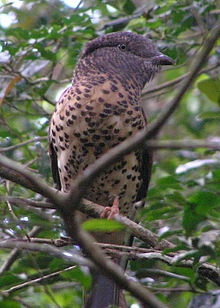- Cuckoo Roller
-
Cuckoo Roller 
Female or juvenile Cuckoo oller Conservation status Scientific classification Kingdom: Animalia Phylum: Chordata Class: Aves Order: Leptosomatiformes (but see text) Family: Leptosomatidae
Blyth, 1838Genus: Leptosomus
Vieillot, 1816Species: L. discolor Binomial name Leptosomus discolor
(Hermann, 1783)The Cuckoo Roller (Leptosomus discolor) is the only bird in the family Leptosomatidae, which is usually considered to be within the order Coraciiformes, which also includes the kingfishers, bee-eaters and rollers. However, the position of this family is not very clear. Morphological evidence may suggest a placement within or near to Falconiformes. In the rather comprehensive DNA study by Hackett et al.[2] this is one of only two birds – besides the Hoatzin – of which the position is not clear, although it seems to be at the root of a group that contains the Trogoniformes, Bucerotiformes, Piciformes and Coraciiformes.
It is also commonly known to English speakers by its French name Courol.[3]
It is a medium-large bird, inhabiting forests and woodlands in Madagascar and the Comoro Islands. There are three subspecies; the nominate L. d. discolor is found in Madagascar and Mayotte Island, L. d. intermedius on Anjouan, and L. d. gracilis of Grand Comoro. Based on its smaller size, differences in the plumage, and minor difference in the voice, the last of these is sometimes considered a separate species, the Comoro Cuckoo Roller (L. gracilis).
Contents
Description
The Cuckoo Roller has a total length of 40–50 cm (16–20 in), with nominate being largest, and L. d. gracilis smallest. Unlike the true rollers and ground rollers, where the sexes have identical appearance, the Cuckoo Roller is sexually dichromatic. Males have a mostly velvety grey chest and head, changing gradually to white on the remaining underparts (demarcation between grey and white stronger in L. d. gracilis). The back, tail, and wing-coverts are dark iridescent green with a purplish tinge (especially on the wing-coverts), and the crown and eye-stripe are black. Females are mostly brown with strongly dark-spotted pale underparts (less spotting in L. d. gracilis). Juveniles are generally reported as resembling a dull female, but at least juveniles of L. d. gracilis are sexually dimorphic, and it is possible this also applies to the other subspecies.[3] The bill is stout and the eyes set far back in the face. The legs and feet are small, and the feet have an unusual structure which has confused many ornithologists, but is now thought to be zygodactylous.
The diet of the Cuckoo Roller is not well known, but a 1931 expedition found that chameleons and insects, particularly locusts and caterpillars are important food items.[3] Stomach have often been found lined with the hairs of caterpillars, and other prey taken include grasshoppers, cicadas, stick insects and geckos. The principal foraging technique is to perch motionless watching for prey, then to make a quick sally towards the prey when observed. They will also forage from the air. Prey is caught in the large bill and dispatched by beating it against a branch.
Very few studies have investigated the breeding biology of the Cuckoo Roller. It has been described in the past as a polygamous breeder, but there is no evidence for this.[3] The nest is located in tall trees, 4–6 m off the ground, in natural cavities. No lining is placed inside the cavity, the white eggs are laid directly on the bottom. The usual clutch size is around four eggs. Incubation is performed by the female only, with the male feeding her while she is in the nest. The incubation period is about 20 days, after which fluffy chicks are born. Chicks remain in the nest for 30 days before fledging.
Relations with humans
The Cuckoo-roller is described as being very tame, and it is generally not disturbed by the inhabitants of Madagascar, many of which have legends and myths about the species. It is regarded by many as a good omen and the harbinger of clear weather. It tendency to be seen in pairs also has brought about an association with couples and love. The species is not generally hunted and has proven resistant to habitat change that has threatened other native birds, and is considered least concern by the IUCN.
References
- ^ BirdLife International (2004). Leptosomus discolor. 2006. IUCN Red List of Threatened Species. IUCN 2006. www.iucnredlist.org. Retrieved on 11 May 2006.
- ^ Hackett, S. et al. (2008) "A Phylogenomic Study of Birds Reveals Their Evolutionary History " Science 320 (5884) 1763 - 1768
- ^ a b c d Goodman, S (2001) "Family Leptosomatidae (Cuckoo-roller)" in del Hoyo, J.; Elliot, A. & Sargatal, J. (editors). (2001). Handbook of the Birds of the World. Volume 6: Mousebirds to Hornbills. Lynx Edicions. ISBN 848733430X
External links
- Cuckoo Roller videos, photos & sounds on the Internet Bird Collection
Categories:- IUCN Red List least concern species
- Coraciiformes
- Higher-level bird taxa restricted to the Malagasy region
- Genera of birds
- Monotypic bird families
- Birds of Madagascar
Wikimedia Foundation. 2010.


